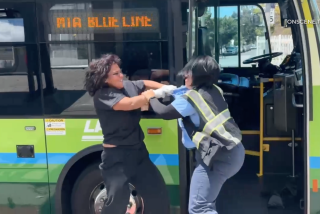Volunteers Radio License Numbers to Police : ‘Drunk Busters’ Spot Impaired Drivers
- Share via
LOUISVILLE, Ky. — George House has been obsessed with getting drunks off the road since his son saw 27 people die when their church bus was hit last year by a truck driven by a man now charged with drunk driving and murder.
Eighteen-year-old Chris House “was riding a bus behind the one that was hit near Carrollton. When he got home, he was still shaken by what he had seen and heard. Some of the kids that died were close to his age.”
George House, a Transit Authority of River City bus driver for 11 years, “sat down and wrote my company, suggesting that any of our drivers who spotted a drunk behind the wheel should alert the dispatcher to call police.”
The Transit Authority took House’s idea to police, who got $1,900 to pay for “Drunk Buster on Board” stickers for participating vehicles.
About 5,000 Volunteers
The idea caught on, and there are about 5,000 volunteers like House in the Louisville area, all equipped with two-way radios. They are the anonymous tipsters who have made “Drunk Busters” a success in Jefferson County and have drawn the attention of law enforcers from Florida to Wyoming.
“We now have 25 firms involved, and more should come on board later. There’s such a diversity of spotters that the offender won’t know whether the information leading to his arrest came from a guy behind the wheel of a cement mixer or one driving a floral van,” police spokesman Bob Yates said.
Police have received more than 100 calls since Drunk Busters began in December--seven months after the Carrollton accident--and although it would be difficult to track each tip in the courts, Yates said drunk-driving arrests are up 19.1%. There were 977 arrests in the first quarter for driving under the influence, compared to 820 in the 1988 quarter.
Requests for Information
Police have gotten requests for information from around the country. One inquiry came from Paul Feiner, a member of the Westchester County, N.Y., board of legislators, which planned to recommend adopting the plan. “I would consider the program a success if it gets just one deadly driver off the highway. I think it makes sense to get people to work with the police,” he said.
David Shedd, president of a beer distributor, was critical of Drunk Busters when it was unveiled just before the Christmas holidays.
“Our industry was under attack about that time and I thought this was another shot being fired at us,” Shedd said. “I had volunteered the services of my employees to help put out a packet covering drinking and driving.”
The packets went to motels, hotels and restaurants and offered hints on how bartenders could recognize customers who had too much. Shedd understands the intent of Drunk Busters, “but the application bothered me.”
House, 39, a former county corrections officer, has turned in three suspected drunk drivers recently. “One of them had a can of beer between his legs and a case on the seat beside him,” he said.
Signs of Drunkenness
He and others like Roger Coffey, owner of a 23-wrecker towing fleet, have learned to spot signs that a motorist may be under the influence.
“They always slow down when they’ve had too much liquor. If the driver is going 25 m.p.h. in a 55-m.p.h. zone and he isn’t elderly or half blind, watch out,” Coffey said. “You also have to take a second look at the guy whose vehicle is weaving in the roadway, straddling the middle line or accelerating and decelerating rapidly.”
He said his employees so far have made “25 to 30 calls.”
Because of the nature of his business, Coffey had doubts about joining the program. “We’re the only towing service in it, but we’ve never towed a drunk that we turned in,” he said.
More to Read
Sign up for Essential California
The most important California stories and recommendations in your inbox every morning.
You may occasionally receive promotional content from the Los Angeles Times.













